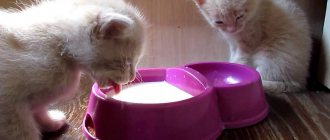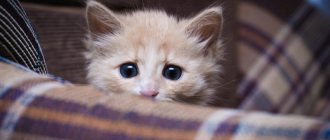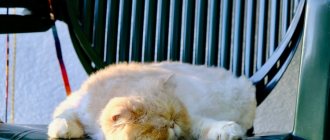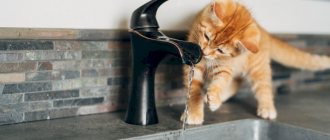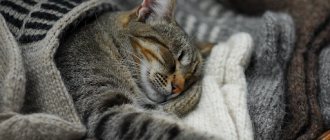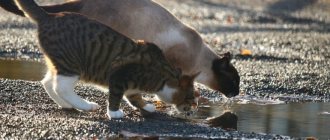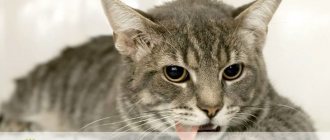(Be the first to vote!)
5589564
06/18/2021 owner reviews
In general, if a cat is drinking more water than usual, this is not normal and is usually a sign that something is wrong. An average 4kg cat should take approximately 180ml per day. If she is overweight and also urinates a lot, this means that something is going on and we should contact the vet.
The exception is when the weather is generally hot, when the animal must compensate for body temperature and fluid loss by increasing water intake, which is quite common in all animals. This may be the reason, especially for very active cats.
However, it is not common to see a cat drinking large amounts of water alone. In fact, it is often their owners who must encourage the animal to eat the minimum daily amount. This reduction in consumption in cats comes from their ancestors, cats that lived in the desert and adapted to survive in this habitat.
This does not mean that a cat does not need water to live, because nowadays, due to the industrialization of food and other changes in the daily life of domestic cats, we know that water consumption is necessary to maintain a good quality of life. However, when a cat drinks more water than usual and does it suddenly, this is normal for us. So we'll talk about why your cat drinks a lot of water and what to do next.
- How much water does a cat drink per day?
- How much water should a cat drink per day?
- Why does a cat drink a lot of water?
- The kitten drinks a lot of water, is this normal?
- The cat drinks a lot of water and vomits
How much water does a cat drink per day?
First of all, it is important to consider the normal amount of water a cat should drink per day. To do this, it is necessary to know the cat's routine and personality, since polydipsia (when the cat drinks more water than usual) and resulting polyuria (when the cat urinates more than usual) are symptoms that may go unnoticed and therefore may not be noticed by caregivers. it takes a while to realize that something is wrong.
© shutterstock
How to properly water an animal
Getting your cat to drink more than usual is not that difficult. In the absence of pathologies, the reason for rare trips to watering places lies in improper drinking water or questionable water quality. If you understand each of these points, then you don’t have to worry about the health of your mustachioed pet.
Selection and installation of a drinking bowl or bowl
Choose ceramic or glass bowls. Plastic products often leave an unpleasant odor and quickly accumulate bacteria. If the main material is metal, then it can produce glare that frightens or misleads the animal.
When drinking, a narrow bowl can injure the vibrissae, so it is better to take a wider one.
It is also important not to forget about hygiene: the drinking bowl must be washed daily.
If your animal refuses to drink from a bowl, but loves a stream from the tap, buy him a drinking fountain. This device filters the liquid poured into it and enriches it with oxygen. Another option is to install a faucet filter.
Sometimes the problem lies not in the drinker, but in the place where it is installed. Not all animals like to drink in the kitchen. Place filled containers throughout the house and see which one your cat drinks from most readily. Very often, mustachioed pets prefer the owner's cups left unattended. Be prepared to share your supplies for the sake of your pet's health.
How much water should a cat drink per day?
Water intake considered normal for a domestic cat is 45ml per kg day, increasing this amount will also increase urine output, so if the cat is urinating too much it may be that water intake has also increased. Since this sign is often the first symptom perceived by the animal's handler, the veterinarian may choose to perform a series of laboratory tests to examine the cat's urine and calculate the difference between water intake and the amount of water excreted to make an accurate diagnosis and prescribe the correct treatment. Some procedures sometimes require sedation and the passage of a catheter through the urethral duct, so they can only be performed by a specialist.
However, there is a method you can try at home to check if your cat is drinking more water than usual. This method is nothing more than using a measuring cup or measuring it with a separate meter to measure the amount you put in the cup at the beginning of the day and the amount they drank at the end of the day. Once you have your dose, simply divide this value by your cat's weight.
If the end result is more than 45 ml per kilogram, contact your veterinarian. Of course, for this method to work, you must ensure that your cat only consumes water from its own bowl and is not one that prefers to drink water from other sources such as glasses, plants, taps, etc. if you If you live with several cats and they all use the same water bowl, the results will be unreliable.
What affects water consumption
The daily water requirement for a cat is individual. With age, due to a slowdown in metabolic processes, it gradually decreases. A larger deviation is typical for pregnant pets - when carrying kittens, part of what they drink is transformed into the amniotic sac and milk.
In addition to age and physiological condition, it is necessary to take into account several more important factors: the type of feeding, the mobility and size of the animal, as well as the climatic conditions in the place of residence.
Nutrition
When feeding natural food, up to 75% of the liquid comes from food. The cat gets moisture from fermented milk products, vegetables, herbs, cereals, meat and fish.
With dry granules, the animal receives only 10% liquid. To maintain water balance and comfortable digestion of food, you need to drink a portion that is 2 times the volume of what you eat. Otherwise, an increased concentration of proteins and minerals may result in the formation of stones (kidney or bladder stones).
Body type and activity
The greater the mass of a mustachioed pet, the less its norm per kilogram. Calculation formulas for a miniature cat weighing only 2 kg and a large cat whose weight exceeds 10 kg will be different. In absolute terms, an animal with a powerful physique will have to drink more, but in relative terms, the need will be higher for those who are smaller.
In addition to size, daily activity is also important. Cats that roam freely on the street expend more energy and moisture reserves than those that spend almost the entire day on the couch.
Ambient temperature
Increased human sweating plays an important role in thermoregulation. Thanks to sweat, people can tolerate heat much more easily than pets. In the cat family, sweat glands are located on the pads of their paws - this is why wet marks from cat paws appear on the floor in the summer.
To lower their body temperature, mustachioed pets lick themselves more often, covering their coat with copious amounts of saliva. When it evaporates, a short-term cooling effect occurs. Accordingly, the cat drinks more than normal to produce a copious amount of saliva.
The higher the ambient temperature and the drier the air, the faster moisture is lost. In damp and cool weather the situation is reversed.
Why does a cat drink a lot of water?
As mentioned above, polydipsia and polyuria are symptoms, not diseases. So, if your cat drinks a lot of water and urinates frequently, these are common signs of the following health problems:
- Diabetes
- Kidney or urinary tract infections
- Thyroid diseases
- Liver failure
- Hyper or hypoadrenocorticism.
Additionally, the use of certain medications, such as steroids and some anti-inflammatory drugs, also cause the animal to increase the amount of urine they produce, which they try to compensate by increasing their water intake.
On the other hand, if your cat is an adult, obese and you notice that she is drinking a lot of water and urinating more often than usual, do not hesitate to contact your veterinarian as soon as possible, because if the problem is not treated in time, the pathology could be fatal. outcome.
© shutterstock
Medicines
Another reason why a cat often drinks water is drug treatment. Some medications can cause thirst in cats. However, this phenomenon is not considered normal; it is a side effect of the medication. It usually occurs because the cat is given the wrong treatment.
Diuretics and corticosteroid drugs can cause a cat to suddenly start drinking large volumes of running water. In rare cases, taking Xylazine can cause illness.
If during therapy a person notices that the cat drinks a lot of water, then the veterinarian should be informed about this. You may need to change your treatment regimen by changing the dose of the medication or stopping it altogether.
The kitten drinks a lot of water, is this normal?
If you just adopted a kitten and notice that he is drinking a lot of water and urinating too much, consult your veterinarian about the possibility of any of the above problems, as well as urinary tract infections. If the problem is detected at an early stage, the animal will better tolerate the entire treatment process. Additionally, if, for example, they are diagnosed with diabetes or a thyroid-related condition, the sooner new changes are made to their daily diet and care regimen, the better for them, since there is no cure for these problems.
What does each discharge indicate when vomiting occurs?
Of course, an animal can vomit not only bile, but also other types of secretions. In order not to cause unnecessary panic, you need to understand the specific cause of this type of vomiting.
We suggest you familiarize yourself with: Shells of marine mollusks, how to remove a mollusk from the shell
Before the onset of this symptom, the pet will experience rapid breathing, and involuntary reflexes may appear, namely swallowing. There is also strong salivation.
Before the onset of vomiting, the pet notices rapid breathing
If spasms begin after eating, this may indicate that your pet has eaten too much grass or swallowed a large hairball. This caused irritation in the stomach.
For example, if a cat has vomited 1 or maximum 2 times and feels quite normal, then there is no particular reason to worry. You just need to monitor your pet’s condition for 24 hours, and if everything is fine, then you don’t have to see a doctor.
It is important to understand that inflammation of the uterus or intestines, as well as feline distemper, are also accompanied by such discharge. Therefore, if these symptoms are systematic, you should not postpone a visit to the doctor.
White foam is considered the safest; if an animal burps such a mass, then there is no need to worry too much. Of course, if this is a one-time spasm.
The most common cause of bile secretion is considered to be problems with the liver or kidneys.
If we are talking about bile or blood, then you should be especially careful. The most common cause of bile secretion is considered to be problems with the liver or kidneys. The same reason may be for green discharge. Moreover, in the latter case, in addition to liver disease, stomach problems cannot be ruled out.
When there is blood in the discharge, there may be other reasons. For example, scarlet blood indicates any damage to the pharynx or esophagus. The first thing you need to do is examine your pet's throat; most likely, wounds will be found there. Dark blood indicates damage to the stomach itself; here you cannot do without the help of a doctor.
If you are vomiting, you need to examine your pet's throat.
The cat drinks a lot of water and vomits
As we have already said, often the symptoms of cats are not perceived by the owners in time, which complicates the clinical picture and contributes to an imbalance in the body as a whole, as a result of which the animal’s initial signs worsen and other associated signs appear, such as vomiting, apathy, loss of appetite, etc. ., therefore, if your cat is drinking too much water and not eating or eating too little, there may be a serious cause.
For all of the above reasons, when you notice the first symptom in your cat, be it an increase in water consumption, an increase in the amount of urine, vomiting, lack of appetite, weight loss... contact your veterinarian immediately, as the pathologies mentioned in the previous sections must be treated as soon as possible.
Consumption rate
There are no general water consumption standards for cats. Their need for fluid depends on many factors - weight, age, individual characteristics and general health. You can calculate the approximate rate of water consumption for a cat: about 30 ml of water is required per kilogram of weight. Based on these data, it turns out that a cat that weighs 7 kg should drink 200 ml of water per day, that is, 1 glass.
- Thirst torments...
Attention! With age, a cat's need for water increases due to the natural decrease in the amount of fluid in the body. That's why older pets drink more than young ones.

